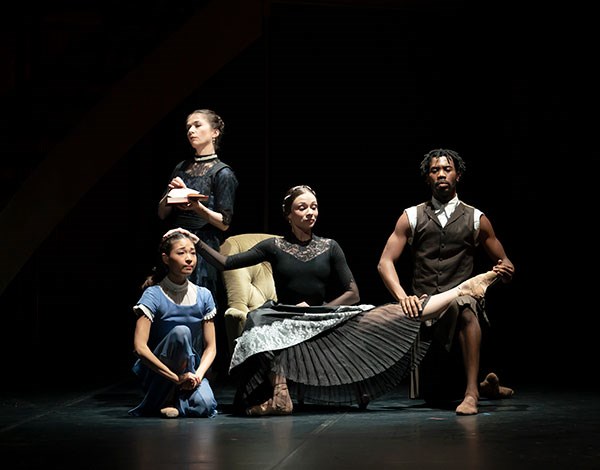Words by Saoirse O’Connor
I spent my Saturdays through Sixth Form volunteering in an old country manor once owned by Queen Victoria’s favourite prime minster. The (bright yellow) bedroom was lined with gifts from the Queen to her prime minster including many, many pictures of her children each topped with its own golden crown. One of these was a portrait of Princess Beatrice, a woman who I knew nothing about except that she was the youngest child of Victoria and Albert. When going to see a ballet called ÔÇÿVictoria’, it was a surprise that the first act was devoted to the relationship between the Queen and her youngest child. Its an idea that doesn’t entirely pay off if you haven’t stumped up for a programme. My date for the evening was confused until I explained that Beatrice was reading Victoria’s diaries in the present, while the rest of the cast dance the flashbacks.
Beatrice was the transcriber and sometime censurer of her mother’s diaries after Victoria’s death, and it is this role that the ballet focuses on. Beatrice (a superb Pippa Moore) reads each volume with a mixture of anger and longing, both for her now dead mother and for the past she can no longer reach. She watches, sidelined, as Victoria (Abigail Prudames) controls her younger self (Miki Akuta) often physically steering her way from the adult world of court into her own suffocating embrace. Even when Beatrice breaks free of her overbearing mother to marry the handsome and dashing Liko Victoria remains an incumbent presence within the marriage. Abigail Prudames in this sequence does a wonderful job of bringing a depth to Victoria as a mother desperately clinging to her child knowing she must let her go, but also clearly shows how Victoria sees in Beatrice the last remnant of her beloved Albert. Equally excellent, is Beatrice’s own interactions with her younger self. The stunning choreography has Beatrice a silent third in her younger self’s interaction with her husband. The romance unfolds while the older Beatrice joyously relives the past, only for it to cruelly reach its predestined conclusion with Liko dying in the Ashanti war. Other snapshots like Victoria’s intimacy with John Brown are brutally emphasised by Beatrice’s furious tearing of pages from the respective volume. Beatrice’s role as devoted daughter is subverted a little in the censoring of her mother’s private diaries, her anger and sense of loss due to the control her mother had over her life coming to fruition at the end of Act One as Victoria dresses her daughter in widow’s mourning dress. Beatrice looks down at the black dress she is still wearing as the curtain falls, a look of horror on her face.
If in Act One Victoria’s diaries provide her daughter with a means of remembrance in Act Two they’re a means of discovery. It’s a small realisation, but a nice moment when the audience realises that Beatrice’s lasting image of her mother is the same as ours. The small imperious lady in black who may or may not be amused. But of course, there’s another Victoria, the young passionate (though still imperious) Victoria whose love affair with her husband lasted well after his death. It is this Victoria that her daughter now discovers. Abigail Prudames copes admirably with this change of pace, and the second act is probably far closer to what you expect when attending a ballet about Victoria’s life. The staging works better here than in the first act (the stage is a library full of Victoria’s diary volumes), with the shelves slowly filling with newly edited and transcribed bound books as Beatrice makes her way through her mother’s life. The second act is fairly linear, touching a little on Victoria’s tempestuous relationship with her mother, her courtship with Albert and the birth of her many children.
It is the last sequence which is the highlight of the 2-hour traffic of this stage. Victoria’s children begin to clutter the side of the stage, while their mother runs back and forth between childbirth and politics, one nearly as arduous as the other. Both the audience and her youngest daughter suddenly realign and forgive the queen her tempestuous and controlling actions of the first act, especially as Albert grows suddenly sick and dies his wife stricken by his side. In a beautiful moment of reconciliation, the elder Beatrice takes her infant self from the nursemaid and places the bundle in her mother’s arms. It’s a moment that mirrors the historical Victoria’s actions at Albert’s death, supposedly he ran to nursery, wrapped her four-year-old daughter in her dead husband’s dressing gown and took her to bed. Here this story is re-contextualised with the elder Beatrice giving herself willingly to her mother in her hour of need. The romance with the ballet is on mother and daughter, and the final image of Beatrice literally positioning her mother to be both sovereign and mother is poignant and arresting.
The performances of the entire company are deeply arresting and played with real depth, while choreography and music is beautifully used for the storytelling, While the first act may be initially confusing, the performance is superb in its entirety.



